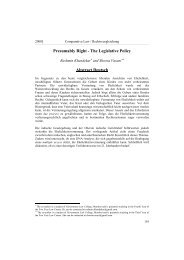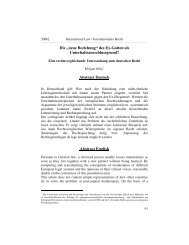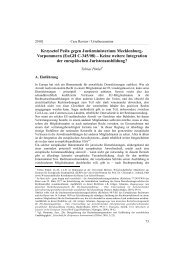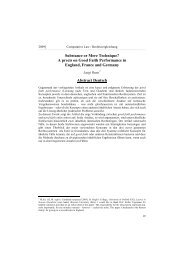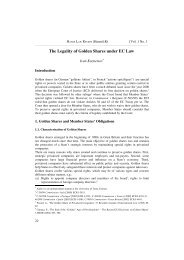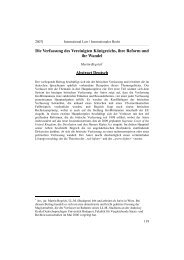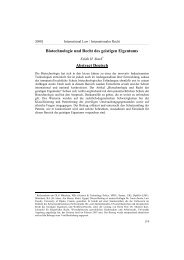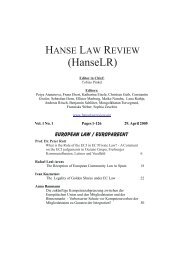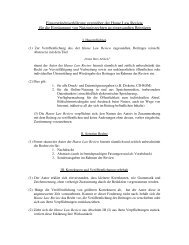The United Nations – a Kantian Dream Come True? - Hanse Law ...
The United Nations – a Kantian Dream Come True? - Hanse Law ...
The United Nations – a Kantian Dream Come True? - Hanse Law ...
Create successful ePaper yourself
Turn your PDF publications into a flip-book with our unique Google optimized e-Paper software.
2009] International <strong>Law</strong> / Internationales Recht<br />
___________________________________________________________________________________________________________________________________________________<br />
fifth preliminary. Its similarity to the non-intervention clause in Art 2 (4) of the Charter of<br />
the <strong>United</strong> <strong>Nations</strong> is salient. 47<br />
<strong>The</strong> sixth preliminary article, finally, defines the boundaries of legitimate warfare. <strong>The</strong> fact<br />
that not the allowance for confidence during a future peace but mainly considerations of<br />
humanity constituted the motivating rationale of the Geneva Conventions notwithstanding,<br />
spiritual similarities between the Conventions and Kant’s sixth article can hardly be denied.<br />
That in practice, the international state community has failed to put at least half of the<br />
<strong>Kantian</strong> requirements into effect is another matter. 48 Instead of abolishing standing armies,<br />
even the UN Charter itself relies on the military forces of its member states, when they are<br />
obliged by Art 43 UNC to put their armed forces at the disposal of the UN organs should<br />
the Security Council require so. When, during the cold war period, the UN did not succeed<br />
in stopping the arms race, the financial basis for which <strong>–</strong> in violation of the fourth<br />
preliminary article <strong>–</strong> often were debts, 49 deficiencies of implementation in international<br />
practice were openly displayed. Even the fifth preliminary article, seeming closest to the<br />
status quo in theory, in practice reveals a weak degree of implementation as several<br />
examples <strong>–</strong> probably the most recent one being the US invasion in Iraq <strong>–</strong> illustrate. 50<br />
2. <strong>The</strong> Definitive Articles<br />
Whereas the preliminary articles state prohibitions the definitive articles lay down positive<br />
obligations. <strong>The</strong>y offer the positive conditions for peace, 51 by prescribing three<br />
requirements.<br />
(1) <strong>The</strong> civil constitution of every state shall be republican. 52<br />
(2) <strong>The</strong> right of nations shall be based on a federation of free states. 53<br />
(3) Cosmopolitan right shall be limited to conditions of universal hospitality. 54<br />
In three short articles Kant sketches the leading principles of his entire theory of public<br />
law. 55 As a guideline Kant posits: ‘[A]ll men who can at all influence one another must<br />
adhere to some kind of civil constitution.’ 56 In short: the non-legal state of nature has to be<br />
overcome in all possible relations. <strong>The</strong>refore the nation state (the relations between<br />
individuals <strong>–</strong> first definitive article), the international peace federation (the relation between<br />
states <strong>–</strong> second definitive article) and cosmopolitan law (the relation between individuals<br />
and foreign states <strong>–</strong> third definitive article) constitute the three levels of constitutional order<br />
for men, which are necessary to the idea of perpetual peace. 57<br />
47 Laberge, Pierre, ‘Kant on Justice and the <strong>Law</strong> of <strong>Nations</strong>’, in Mapel, D.R. and Nardin, T. (eds), International<br />
Society <strong>–</strong> Diverse Ethical Perspectives (Princeton University Press, Princeton, 1998), 82, 94.<br />
48 Höffe, ‘Ausblick: Die Vereinten Nationen im Lichte Kants’, 256. Immediately after the Second World War<br />
Friedrichs conclusion leaves little hope for the <strong>Kantian</strong> project: ‘Now it can be readily seen that virtually none of<br />
these conditions are fulfilled at the present time. [...] it is apparent that no time in recent centuries has been as<br />
unpromising in terms of these conditions as the present moment.’ (Friedrich, 19).<br />
49 Höffe, ‘Ausblick: Die Vereinten Nationen im Lichte Kants’, 256.<br />
50 Ibid. with further examples.<br />
51 Klenner, 3.<br />
52 Kant, ‘Perpetual Peace’, 99.<br />
53 Ibid., 102.<br />
54 Ibid., 105.<br />
55 Lorz, Ralph Alexander, ‘Die dauerhafte Aktualität des Ewigen Friedens <strong>–</strong> Neuere Entwicklungen zur<br />
Interpretation der Friedensschrift Kants’, [1998] 37 Der Staat 75, 78.<br />
56 Kant, ‘Perpetual Peace’, 98 in note *.<br />
57 Cavallar, Kant and International Right, 52; Friedrich, 21; see also the explanatory note by Kant, ‘Perpetual<br />
Peace’, 98 note *.<br />
55



